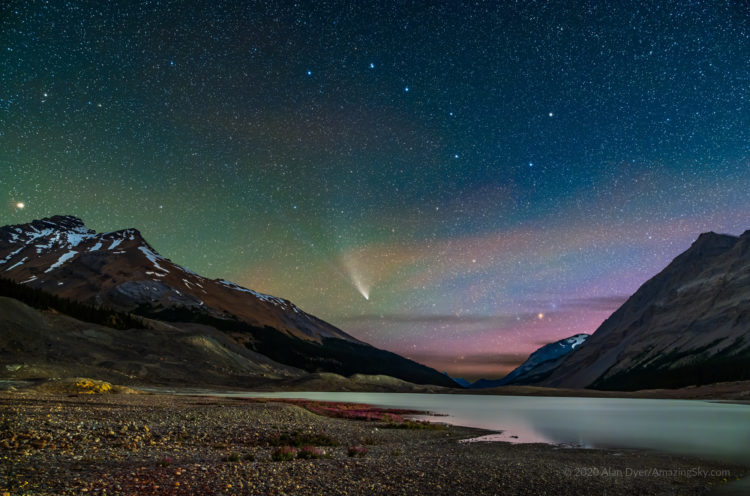Comet NEOWISE at the Columbia Icefield
Description
Comet NEOWISE (C/2020 F3) on July 27, 2020 from the Columbia Icefields (Jasper National Park, Alberta) from the Toe of the Glacier parking lot, looking north over Sunwapta Lake, formed by the summer meltwater of Athabasca Glacier. So this is a portrait of ice in the sky and icy water on Earth.
This was my parting shot of the comet, as it was fading rapidly at this time receding from Earth, though it was still naked eye. Plus the waxing Moon was going to be lighting the sky much more in the following week. So this was the night!
While it was pale to the eye, the long expposure of the camera did pick up the blue ion and white dust tails very well. The ion tail extends about 15° and the dust tail at least 10°. The tails are certainly more prominent than in 99% of any comets we see any given year! So this was still a nice comet!
Red and green bands of airglow, some faint magenta aurora on the horizon, and some lingering blue perpetual twilight at his northern latitude all tint the sky. The Big Dipper stars are at top. Arcturus is at far left. The orange star at bottom is Tania Australis, here made a little larger by it shining through some thin haze.
This is an exposure blend of a stack of 4 x 4-minute untracked exposures for the ground, with 4 x 2-minute tracked and stacked exposures for the sky. Stacking the images smooths noise. Tracking the sky prevents star trailing in the long exposures required to reveal the faintest stars and the subtle comet tails.
The camera was on the iOptron SkyGuider Pro tracker. For the ground shots I simply turned the tracker motor off. All with the 24mm Sigma Art lens at f/2.8 and Canon EOS Ra at ISO 1600 for the ground and ISO 3200 for the sky.

comments (0)